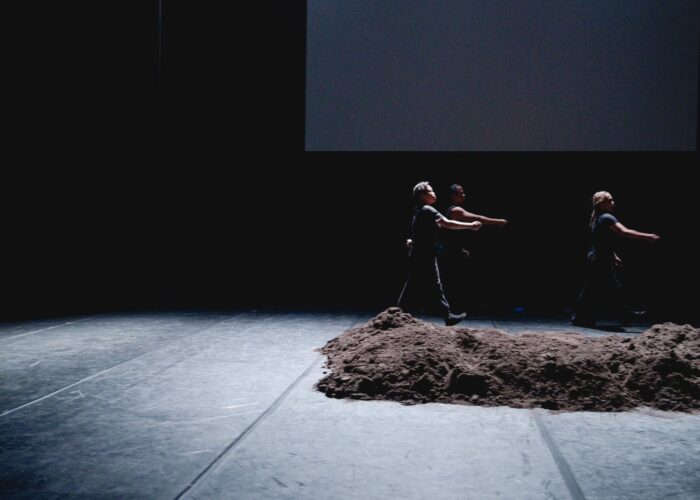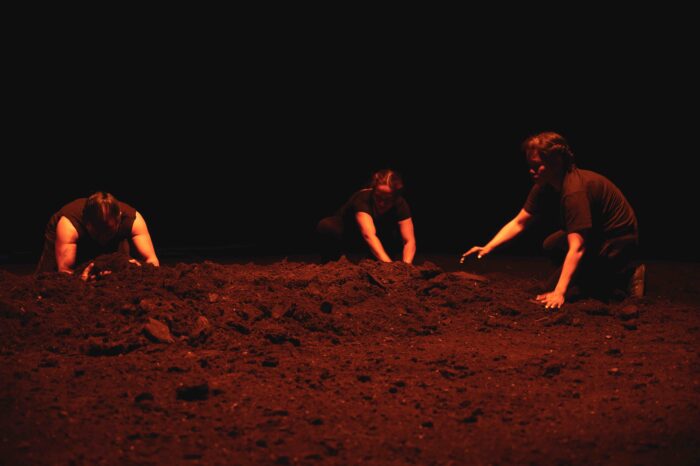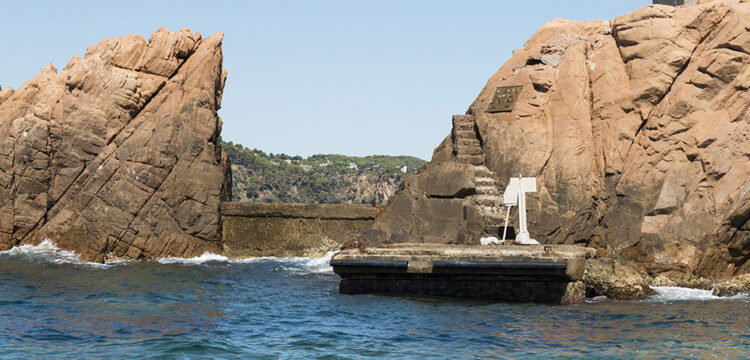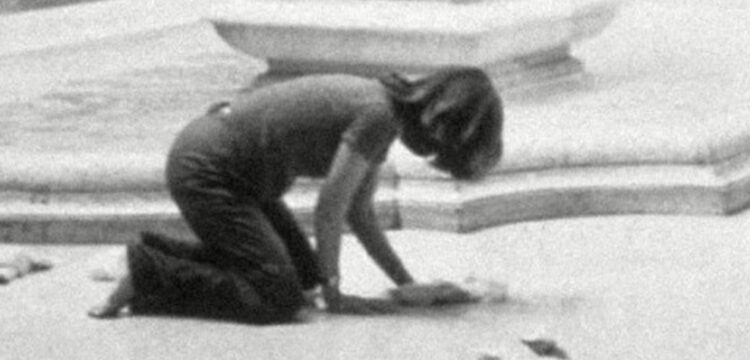Being Contemporary
Forming and informing the present: a conversation among Liryc Dela Cruz, Alex Gence, and Loreleï Regamey
We met Liryc Dela Cruz in the context of the CCC summer school “Documenting Shadow Knowledge” hosted by the Istituto Svizzero in Rome and were fortunate enough to be there for the last days of his exhibition “Il Mio Filippino: For Those Who Care To See” at Mattatoio. The relevance and generosity of Liryc’s contribution to the summer school compelled us to invite him to take part in a conversation to further discuss the implications of his work and the state of research by the means of art today. We warmly thank Liryc for accepting our invitation and are happy we can share the complexity and agency of his work in a dialogical manner.
This conversation was originally published in the first issue of SEARCCCH in January 2024. SEARCCCH is a publication of the Master program CCC – Critical Curatorial Cybermedia in the Visual Arts Dept. of HEAD – Genève, University of Art and Design in Geneva.
Alex Gence: How and when did you start working on the project Il Mio Filipino?
Liryc Dela Cruz: I started this project in 2017 when I arrived in Italy. At the time, I was doing housework, since when you go to the Filipino community and ask them: “Do you know if there’s any job for me?”, they always answer: “Of course, since you’re a Filipino you can do domestic work”. So from 2017 to 2018, I was being trained by Filipino workers to do cleaning and domestic work. The fact that these were the most readily available jobs for me, can partly be explained by how the Philippines and Italy created and structured the “Filipino workers” identity. This, we can trace back to the 1970s, when the Philippines and other Western countries or rich countries solidified the economy of exhaustion. I think I can call it the economy of exhaustion, this exportation of manpower. During the time of martial law and dictatorship in the Philippines we had so much debt in other countries and also in the global economic institution that our president, the dictator Ferdinand Marcos, started sending Filipinos as workers to Western countries to pay debts for our country.
AG: The historical context of how that economy and an economy-based identity was formed is really interesting. As you said, the consequences of this economy of exhaustion is also the point of departure for your work from the moment you arrive in Italy. As you already had an artistic practice, how did that influence the way you decided to develop your work in that context?
LDC: Before arriving, I was already doing cinema. I started doing cinema when I was 16. Informally, I had also been doing performance since I was young. But my artistic practice, what I consider my professional practice is Cinema. When I arrived in Italy, I started cleaning jobs and domestic jobs, but then I said, okay, how can I still do artistic things through Cinema? So I decided to document these workers that taught me how to clean, who also really collaborated with me and really took care of me.
I eventually consulted my mentors in the Philippines to ask how I could create a choreography from the movements of cleaning workers because, in the Philippines, our folk dances and some traditional dances are based on the movements of farmers, on the movements of animals or on the movement of an event. For example, harvesting or catching fish. I thought that, okay, since these movements are related to labor, why not also, try to dissect and also investigate the movements of domestic workers and how they take care of spaces.
But then, in my documentation, I found that there is a repetition of movements, that isn’t so random. I started to question how this repetition of movements connects to how their bodies were structured, way back in the Philippines, when they were being trained to serve Western countries.
There are public videos on the internet that you can see of the so-called slave schools in the Philippines. In these tutorials, instructions are given, for example: for three minutes you have to clean the table, for ten minutes you have to clean the toilet. These temporalities created certain repetitions and structured the movements in their bodies and were carried out for like 10, 20, 30 years.
I think from here you can see how care and processes and methodologies of cleaning have been redefined. I’m questioning how the idea of care, hospitality, cleanliness and methods of taking care have been redefined by this territory. In this regard, we also have to go back to where these cleaning methods were created, in the Philippines, because they were imagined as an offering, an offering to Western countries so that we can get bigger remittance.
When speaking about the Filipino workers you have to include domestic workers, nurses, seafarers, etc. For example, recently in London, The Department of Tourism from the Philippines made a campaign to promote the country. Instead of depicting places, landscapes and local cultures they chose to use the portrait of a Filipina worker, with the slogan “We offer the world our best”. This is a very strong example on how this political geography has affected people’s identities, how this manpower, the bodies exported to Europe contribute to the image of a country, of a nation.

AG: And when was that?
LDC: It was in 2023, I think months ago this year.
AG: I was going to ask you in terms of your practice, how did you arrive at the form we saw in the exhibition? Something interesting to us is how you articulate your research process, connecting things, finding sources or creating your own sources. Maybe you could talk about how you engage with all these different materials that you have from a methodological standpoint?
LDC: When I started this research it was important for me to not use so much Western feminist theories, because I still question how they are positioning themselves. In a way their theories have been situated in privileges detached from the reality I encountered when working with the Filipino workers. That’s also why I got closer to them, rather than working on theories and detached hypotheses. Still, one of the books that I really value and use in this work is A decolonial feminism, by Françoise Vergès. She’s very upfront in criticizing white feminist theories and she dissects and focuses on black, colored and indigenous women who are doing maintenance work and sustaining the society through labor and domestic work.
I also consulted Filipino groups here in Italy, unfortunately some of them are not that active because they lack time to organize, and they get little or no support from the Philippine government. The problem is that they know that they are in the master’s house due to this colonial legacy of considering Filipinos as resilient. This is also connected to catholicism, Filipinos are mostly catholics and so are Italians. Catholic people who will not speak, but just embrace the suffering. So I had a very limited way to access the bigger issues, because even in the community they don’t talk about it.
I realized that I had to invest in being with the workers, to really understand what they were going through, and they eventually started to open up to me.
This is how I could get a sense of the situations, and not just their personal ones, because each of their lives, individually, are dramatic. What interests me, is the collective experience, because through the collective you can see what their aspirations and their desires are. From there I understood that if I wanted to do research, it had to be one that could resonate with me, because somehow I’m also experiencing what these Filipinos are experiencing. And this research had to focus not only on their suffering but their desires as well.
I was talking, for example, to Gina Apostol, a writer from the Philippines who recently won the Rome Prize for Literature. We talked about the importance of learning and listening to the desires of people, like the domestic workers, because if you just listen to their suffering, you cannot see what’s on their mind. If you listen to their desires, you can also hear them get mad at their employers, how they curse, their living conditions, how they want what they want, how they miss being with their bodies, how they desire having another body. With this kind of approach, I was able to really connect with them, with their wholeness, to humanize them.

Loreleï Regamey: I find your criticisms of western academia interesting, take for example, anthropology, as it is often focused on a certain group of people and not from within the group. So I was wondering, how did you conceive the group? And how was it organized in itself? Was it always collective? Was the group stable all along?
LDC: There’s no organized group because it’s hard to organize them. Sometimes the workers will agree to take part in the project and their employers forbid them to do so. That was one of the challenges in the filming process.
I really tried to engage with them every now and then about why we were doing this project. I wanted them to get comfortable. We discussed the placement of the camera, so we could record their bodies as a whole, to avoid their objectification. I wanted to make sure they felt respected in the process of documenting their work, because there’s always a risk of prejudice when using a camera depending on what you decide to record and how you decide to frame it. All these things have an impact on the direction of your research.
I also wanted to avoid the repetition of recording and documenting the movements of the same stable group. So I met people here, in Rome, but also from Milan and Bologna. This was also important as it made it possible to hear other voices and avoid a one-sided narrative.

LR: It makes me wonder, how did they react to the footage? The videos you presented for your exhibition are reminiscent of the aesthetics of CCTV cameras and video surveillance. How did the workers react to these images of themselves at work?
LDC: The documentation started years before the exhibition at Mattatoio. For example, some of the videos on display were made in 2018, and I always consulted the people I was working with in the process, to make sure we were on the same page. I tried to explain what the exhibition would be and I tried to make the process accessible to them, while not maligning their capacities to understand what we were doing. It’s important for me to translate and transmit my ideas in an accessible way, not using highfalutin or academic words because in the end, it was always a collective project. All the videos in the exhibition were discussed beforehand, to make sure they understood the role they were going to be playing in that context. It’s a kind of negotiation, also challenging my position as the artist taking something from them, to make sure the process and the result are thought out in a collective and collaborative manner.
After every performance we read Françoise Vergès’s book, trying to understand how to relate her idea of decolonial feminism with our colonial history and their lived experiences. This resulted in the translation of academic thinking to make it more relatable to us, by the fact we were absorbing knowledge together. For example, Jenny, one of the participants, thanked me because she was contacted by an Italian filmmaker to play the role of a domestic worker in a movie and she said no, and told them to hire an Italian actor instead. Theory helped her to know that if she wanted to be someone else, she could. And this one small thing was so important! Again, it’s not about saviourism, nor about putting myself as the one who gave them access to something, but rather acknowledging the importance of the shared knowledge that makes it possible to take what is relevant for them while allowing them to take action for themselves. It’s a big thing that this project is doing something that does not only resonate in the art world and in academia. It was made by a community of workers, and it resonates with the community, with the people involved in this geography, and that’s what matters.
That’s why, when people are saying that this is not contemporary art, when a white curator, a white critic or a white artist is telling me that’s not contemporary, I’m done. I used to overthink this notion of contemporary art, as I didn’t study it, or art, for that matter. I believe that being here and doing this now makes us contemporary, in the way we are able to talk about a world that isn’t the one usually told.

AG: That’s something really important in your work, in what you say about an individual practice which becomes a collective process. We are then faced with the question of who your research is addressed to, in a contemporary sense. Then it isn’t not so much about asking oneself about the conditions they are working in rather it becomes a question of self-determinacy. That could be considered a form of activism, a means to create political agency that goes beyond a simple depiction of their living and working conditions.
It makes me think of the common trope where researchers and theorists move out of academia because of its limitations, and find in art something of a refuge, a space where they can work towards something that could become more than just theory. Art research in that sense, is contemporary by forming and informing the present.
LR: Also changing the modes of representation and proposing new narratives that are not yet palpable or visible are an important aspect of art research.
LDC: Yeah, I think it’s very important. In contemporary art we usually question and make speculations about the world we live in, but we lack a real engagement to the people we are getting knowledge from and getting inspiration from, don’t you think? Our imagination and our speculation is just addressing the surface and can be very superficial. The inclusion of people is what makes collective action and imagination stronger. You can hear their dreams and their desires for a different future, because you are with them, you are not alone, as an artist, playing the fortune-teller. We also have to admit that, as artists, it’s often about our egos, it’s tempting to listen only to what you want to hear, to what can serve you in the end. When you start to acknowledge the presence and the importance of other bodies, other perspectives, you can collectively create other possibilities, needed by other people than yourself.

AG: I also wanted to ask you about the use of the term “research” in your practice, as the idea of research in art can mean something specific. Could you tell us when it became relevant for your practice and what it means to you now in your career?
LDC: It’s not new for me, my first films were research-based as well, when I was trained as a filmmaker, working with Lav Diaz, considered to be the father of Phillipine’s independent cinema. I was made into a filmmaker by learning to spend time in the places we would shoot, working on site to understand the temporalities, the challenges of the geography, and I’m happy this is how I was trained. To me, questioning my position, my point of view and my way of formulating hypotheses is also about research; it developed my discernment. Maybe something new with the project Il Mio Filipino is the temporality, the slowness in the development which includes the preparation of the videos and performances. I am working with a different sensibility here, that is informed by the collective and as I am not rushing it, new things can unfold in the process.
AG: And as things are unfolding, are you thinking about the continuity of this project? As you just stated, it’s a long process, but it’s also interesting to know where you see yourself going after this exhibition and with the collective of workers.
LDC: I am slowly giving responsibility to the community of collaborators, so they are also in charge of artistic decisions and production. I am doing my best to distribute my institutional privileges to them, by encouraging them to create new networks of Filipino workers who want to engage in the project. Some of my collaborators came to me, saying their friends want to perform too, and since we chose this kind of platform, this way of engaging with others, we continually try to strengthen it. Not so long ago the idea of performing in museums wouldn’t have seemed possible, it remained a fantasy. Now, I want to make sure that they take themselves seriously, if they are performing then that makes them performers. The audience sometimes works actively against this recognition, telling me that they are not professional performers, that I am the one teaching them how to move, but that’s so wrong! How and why would I teach them? I mean, the movements are coming from them, from what they learn by being who they are, in this particular geography and economy. We are also working towards the involvement of other generations of Filipino workers in Italy, they are a big part of the community, and very important in the expansion of this research. The idea is that this project persits in a community-driven way. On the other hand, I want to do other things, to develop other projects, more personal, on the topic of domestic work. I have this idea of a love letter to my mom, who was a domestic worker in the Middle East, just as other members of my family.

AG: To follow up on that, you talked about strengthening the community and as you said, you are not claiming it for yourself, you are a part of it but you also have your own projects. What kind of very concrete strategies do you wish for in this community, on various levels, in order to strengthen it?
LDC: First of all, I don’t believe in empowerment, it’s a poison to the community, it is like resilience that keeps us in place to accept suffering. To me, the idea of empowerment is a way for governments and power officials to play on our constructed identities, asking for resilience on our part, to build up tolerance to hardship.
LR: Resilience is always a trap.
LDC: Yeah, it’s true and it’s the same with empowerment. What we are doing together is going beyond this superficial empowerment, by opening it up and by acting collectively on wounds that are hardly manageable on an individual level. The condition of Filipino workers is a very silent one, and this silence is caused by the fear of losing everything they worked for, be it their rights, permits and low wages. This is also true for all the other marginalized people in this geography, who are very conscious of the fact that they are living in the master’s house. So for me it’s less about celebrating the importance of the work but rather engaging in a process that allows us to talk about lived experiences without fear. That’s very challenging, and time is always your enemy here, because it’s a ressource they lack, they don’t have time for themselves or their families. One thing I would consider as a success so far is that 70% of our audience for the last performance was Filipino, and that’s huge! Our audience wasn’t from the art circles or museums, our audience was one that could understand, something in the work resonated differently to them.
In the hall, during the performance, we could hear a collective reaction, a collective grief, a collective cry, and that meant alot. I am moved that this happened, because it’s so rare to cry collectively with your people, because this geography keeps us in small spaces, with no place to cry, to tell our desires, or to simply dream. With our collective artistic engagement and our gatherings we are trying to make a space for us to collectively cry, mourn, and to create and imagine the present and future that we want.





